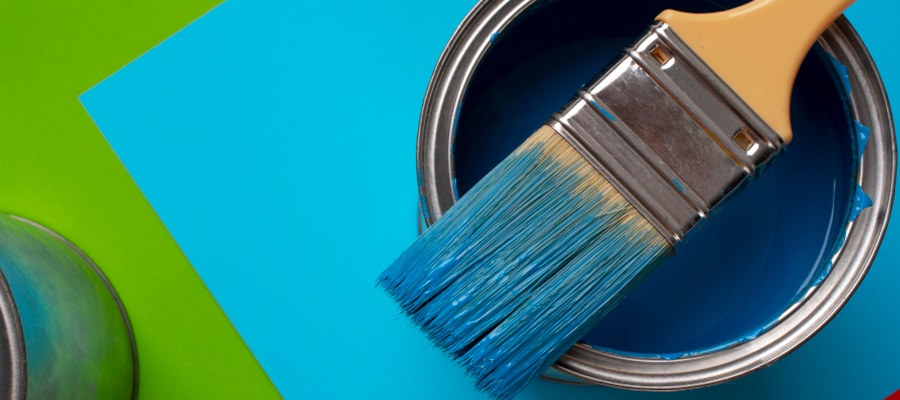The wall colours you choose for your home’s interior design are very influential in shaping the mood and concept. Whatever type of paint and colour you choose for your walls will impact their durability along with their aesthetic appearance. Hence, to achieve a reliable and visually appealing home painting, you need to thoroughly study the different types of paints available in the market and their compatibility with different climatic circumstances.
Therefore, in this blog, Brick & Bolt brings a detailed guide on the different types of paints for home. It will help you to choose the best paint for your home that can endure different weather conditions and provide a long-lasting finish.
8 Types of Paints for Your Home
The following are the different kinds of paint available for your home painting.
- Oil Paint
- Enamel Paint
- Emulsion Paint
- Bituminous Paint
- Cement Paint
- Anti-Corrosive Paint
- Aluminium Paint
- Synthetic Rubber Paint
So, Let’s explore all types of house paints in detail.

1. Oil Paint
Paint is normally divided into two main categories: oil-based and water-based. Oil paint is a blend of pigment particles and an oil, often linseed. You may use this paint as a primer, undercoat, or finish coat. This kind of home paint is great if you want a smooth, rich finish with durability and shine. Additionally, it is water-resistant and simple to clean and apply. However, it takes more than a full day to dry.
2. Enamel Paint
Enamel paint is an impressive choice among the different types of paints available in the market. It is known for its ability to add vibrant colours to homes and various other applications. Enamel paint is highly regarded for its outstanding water resistance, stain resistance, and overall durability. Although these house paint types may be costlier, they offer more than just visual appeal. Enamel paint provides a stunning glossy finish and exceptional durability. Enamel paint is perfect for the various areas of your home, including bathrooms, and can be applied to surfaces like wood and metal. With this paint, you can enjoy a long-lasting and durable coat that can withstand moisture and stains. It’s perfect for high-traffic areas that are prone to wear and tear.
3. Emulsion Paint
In contrast to conventional oil paints, the vast majority of emulsions are water-based and dry quickly. It’s widely used among paint contractors since it’s alkali resistant, has a rich texture, and has better colour retention, making it a long-lasting paint option. As a homeowner, the most significant benefit of water-based emulsions is that they leave no odour and dry rapidly. Acrylic emulsions provide your lovely house with a durable and flexible surface that resists breaking over time.
4. Bituminous Paint
Bituminous paint is a highly functional type of paint that serves a functional purpose by providing a protective layer to the surfaces that are submerged underwater. These particular painting colours hold a unique black shade and are used to coat surfaces for their alkali-resistant, rust-resistant, weather-proof, and water-proof properties. Bituminous paint is incredibly versatile and can be applied to a wide range of structures, including pipes, grills, ladders, wood, metal, and even surfaces that are submerged underwater.
5. Cement Paint

Cement paint, often known as distemper paint, is one of the most common forms of paint used in India. This type of paint is widely used on both interior and outdoor surfaces, acting as a durable barrier against the damaging effects of harsh climatic conditions. It is a flexible option for surfaces that need both increased protection and a bit of aesthetic appeal. Cement paint is available in both paint and powder forms. Its long history gives it a reliable choice for a variety of applications. Cement paint is one of the oldest paint names, providing not only outstanding durability but also a unique wall surface and texture. As a result, the paint may be utilized in a variety of projects, including classic residences and contemporary spaces.
6. Anti-Corrosive Paint
As the name implies, this kind of paint’s basic role is to protect the treated surfaces against corrosion. Anti-corrosion paint formed from sand, linseed oil, and zinc chrome. It is a durable and low-cost paint option for surfaces that are often exposed to air and humidity.
7. Aluminium Paint
This type of paint is commonly chosen for its ability to reflect light and provide protection. It comprises finely ground aluminium flakes, making it ideal for industrial and marine applications. It offers exceptional resistance to heat and UV radiation. It serves as a protective layer against corrosion on metal surfaces and has the ability to minimize heat absorption on roofs.
8. Synthetic Rubber Paint
This particular wall paint is generated through the combination of synthetic resins, solvents, and colour pigments. It is a budget-friendly choice for exterior walls, dries rapidly, and provides exceptional defence against external elements and chemicals. Moreover, it is evenly applicable to broader regions.
Conclusion
On a final note, different types of house paint alternatives are available in the market, from oil-based paint to water-based paint, each designed for a certain surface or purpose. Hence, if you want to pick the ideal paint for your house, it’s crucial to consider aspects like your region’s distinct weather conditions and surface type before choosing the best types of paint for your walls.
Before leaving this page, we recommend you read our blog on exterior wall colour ideas; it will equip you with rich colour combination ideas for your exterior walls.
Elevate Your House Exterior with the Best Colour Ideas

